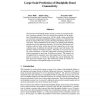Free Online Productivity Tools
i2Speak
i2Symbol
i2OCR
iTex2Img
iWeb2Print
iWeb2Shot
i2Type
iPdf2Split
iPdf2Merge
i2Bopomofo
i2Arabic
i2Style
i2Image
i2PDF
iLatex2Rtf
Sci2ools
NIPS
2004
2004
Large-Scale Prediction of Disulphide Bond Connectivity
The formation of disulphide bridges among cysteines is an important feature of protein structures. Here we develop new methods for the prediction of disulphide bond connectivity. We first build a large curated data set of proteins containing disulphide bridges and then use 2-Dimensional Recursive Neural Networks to predict bonding probabilities between cysteine pairs. These probabilities in turn lead to a weighted graph matching problem that can be addressed efficiently. We show how the method consistently achieves better results than previous approaches on the same validation data. In addition, the method can easily cope with chains with arbitrary numbers of bonded cysteines. Therefore, it overcomes one of the major limitations of previous approaches restricting predictions to chains containing no more than 10 oxidized cysteines. The method can be applied both to situations where the bonded state of each cysteine is known or unknown, in which case bonded state can be predicted with 8...
Disulphide Bond Connectivity | Disulphide Bridges | NIPS 2004 | NIPS 2007 | Proteins Containing Disulphide |
| Added | 31 Oct 2010 |
| Updated | 31 Oct 2010 |
| Type | Conference |
| Year | 2004 |
| Where | NIPS |
| Authors | Pierre Baldi, Jianlin Cheng, Alessandro Vullo |
Comments (0)

